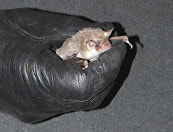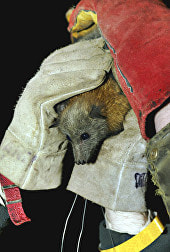ABS safe bat handling guidelines
|
The Australasian Bat Society Inc. (ABS) promotes the safe handling of bats, to mimimise the risks posed by handling to both humans and bats.
Bats sometimes need to be handled for research, conservation, and/or animal welfare purposes. As with all wildlife, the safe handling of bats is important to minimise the risk of transfer of pathogens from bats to humans, from humans to bats, and between bats. Pathogens are microorganisms such as bacteria, viruses, and fungi that cause disease. Some known pathogens, such as Australian Bat Lyssavirus, can be fatal to humans, whilst other lesser-known pathogens may also be harmful to humans, domestic animals, or bats. |
What is safe handling of bats?
|
Safe handling of bats means taking appropriate precautions to prevent the transfer of pathogens from bats to humans, from humans to bats, and between bats. To this end, there are simple, safe handling principles that the ABS expects all members to practice and promote.
Bats should only be handled by people who are:
|
How to handle bats safely and responsibly - in private and public forums
Always practice safe handling of bats in private and public forums. This includes ensuring safe bat practices are portrayed/shown in the media and encouraging others to follow suit.
Never post photos showing bats being handled without suitable personal protective equipment (PPE) on public channels, including on social media or in conference and other public presentations.
Never post photos showing bats being handled without suitable personal protective equipment (PPE) on public channels, including on social media or in conference and other public presentations.
Why safe bat handling is everyone’s responsibility?
Australia’s federal and state biosecurity legislation requires persons to have a ‘general biosecurity obligation or duty’. This means everyone has a shared responsibility to do what is reasonable for them to prevent, eliminate, or minimise biosecurity risks. While it is not expected that individuals will know about all biosecurity risks, it is expected that they will know about the risks associated with their specific industry, business, day-to-day work, and hobbies.
Regardless of whether you handle bats for work, research, wildlife rehabilitation, or other purposes it is important for you to apply these safe handling principles, not only to minimise the risks to human health, but also to avoid the potential negative consequences for our bats.
Regardless of whether you handle bats for work, research, wildlife rehabilitation, or other purposes it is important for you to apply these safe handling principles, not only to minimise the risks to human health, but also to avoid the potential negative consequences for our bats.
What to do in case of a scratch or bite from a bat?
If a person is bitten or scratched by a bat, the Australian Department of Health recommends that that person immediately:
If a domestic animal is bitten or scratched by a bat, seek immediate veterinary advice from the nearest veterinarian or veterinary clinic.
- wash the wound thoroughly with soap and water for at least five minutes;
- apply an antiseptic with antiviral action; and
- seek medical attention from a doctor or nearest public health unit.
If a domestic animal is bitten or scratched by a bat, seek immediate veterinary advice from the nearest veterinarian or veterinary clinic.
Further information
The Wildlife Health Australia Bat Health Focus Group, with input from the ABS, has produced detailed personal protective equipment (PPE) information for bat handlers aimed at preventing the transmission of pathogens from bats to humans and vice-versa.
The Wildlife Health Australia Bat Health Focus Group, with input from the ABS, has also developed detailed information for bat carers, researchers and others interacting with bats to manage the potential risk of transmission of COVID-19 to bats.
Wildlife Health Australia has further prepared National Wildlife Biosecurity Guidelines to help the wildlife community in Australia understand and prepare for risks of wildlife diseases to humans and the prevention of bat-to-bat disease transmission.
Other information can be found here:
Note: links to webpages were accurate at the time of publication (April 2020) – links may have changed since.
The Wildlife Health Australia Bat Health Focus Group, with input from the ABS, has also developed detailed information for bat carers, researchers and others interacting with bats to manage the potential risk of transmission of COVID-19 to bats.
Wildlife Health Australia has further prepared National Wildlife Biosecurity Guidelines to help the wildlife community in Australia understand and prepare for risks of wildlife diseases to humans and the prevention of bat-to-bat disease transmission.
Other information can be found here:
- Queensland: Australian bat lyssavirus and your general biosecurity obligation
- New South Wales: Australian bat lyssavirus and other bat health risks
- Victoria: Rabies and Australian bat lyssavirus
- Western Australia: Rabies and lyssavirus
- Northern Territory: Northern Territory Australian Bat Lyssavirus (ABLV) guidelines for veterinarians
- Tasmania: Bats of Tasmania
- National: Australian Department of Health
Note: links to webpages were accurate at the time of publication (April 2020) – links may have changed since.



